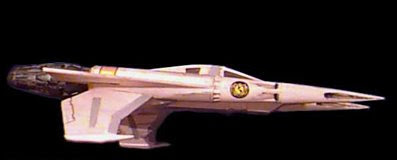 If Modernism had it that Form follows Function, then how do you design something that has an imaginary function? If a reductive functionalism denies the role of culture in shaping the objects we design, then do objects with no function represent a kind of pure form of culture? Do they represent our dreams and fears somehow more purely, because the pragmatics and restrictions of 'real' design have been removed?
If Modernism had it that Form follows Function, then how do you design something that has an imaginary function? If a reductive functionalism denies the role of culture in shaping the objects we design, then do objects with no function represent a kind of pure form of culture? Do they represent our dreams and fears somehow more purely, because the pragmatics and restrictions of 'real' design have been removed?In the 1950's spaceships were rocket shaped and came in bright zingy colours. They zoomed purposefully off into space, styled to suggest a thrusting ambition. UFO's, by contrast were designed by aliens and therefore, for some reason, round. This abstract styling made them ambiguous vehicles, never clearly heading anywhere or with any clear purpose. Their threat was suggested not through aggresive styling but through their mute indifference.
In the late '60's and 70's all spaceships were white, styled like orbiting laboraties, with doors that slid silently open and endless corridors that stretched out like an existential maze. Then, in the 1980's, they became beige like early PC's, their flickering green MS Dos screens representing, perversely, a step back from the blinking colours of the '60's. Space became not a new frontier but a new source of dread, with spaceships full of leaking pipes and slowly failing technology. Today (an oxymoron in science fiction, but still) they seem to have taken on the baroque manifestations of ancient cities, flying pyramids of the sun and the moon, covered in vein like hieroglyphics and of vast planet-like scale. They are, perhaps, something to do with ancient wisdom, a distant sense of civilisation our technology has alienated us from.
The following is a brief, visual and highly partial history of spaceship design.











2 comments:
Hi
May I ask you, where does the term form follows fiction comes from, besides its obvious link to form follows function?
I mean, the first source?
Thank you
loana - logolds@gmail.com
Loana, thanks for your comment. It doesn't come from anywhere that I know, it's just derived, as you say, from the term Form Follows Function.
C
Post a Comment